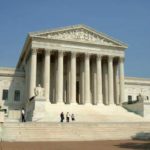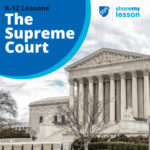Article III establishes the judicial branch of government, which is responsible for interpreting the laws. At the highest level, the judicial branch is led by the U.S. Supreme Court, which today consists of nine justices. In the federal system, the lower courts consist of the courts of appeals and the district courts. Learn more about judicial independence and judicial review in the National Constitution Center’s learning module.
Distance Learning: Civics for Civic Engagement in the Federal Courts
Distance learning activities become civics for civic engagement when federal judges bring the rule of law, separation of powers, judicial independence, and jury service into students’ daily life. Student voice is incorporated into every activity. Teachers and students can explore the pillars of literacy: rule of law, separation of powers, and judicial independence. With the guidance of federal judges and attorney volunteers in virtual court hearings, students learn and practice civil discourse skills as the foundation of effective dispute resolution in the law and in life.
What Makes a Good Judge?
This lesson focuses on the costs and benefits of various judicial selection methods. Students will list characteristics they think essential or valuable to being a good judge, and then see which system of judicial selection – appointment, merit, or election – obtains the highest quality judges. In discussing each method, students will understand the tradeoffs between accountability and independence in judicial selection.
A Conversation on Judicial Independence

Justices Stephen G. Breyer, Anthony M. Kennedy and Sandra Day O’Connor and high school students discuss why an independent judiciary is necessary and how Article III, Section1, in the Constitution safeguards the role of judges. This video complements the documentary An Independent Judiciary: Cherokee Nation v. Georgia and Cooper v. Aaron.
The Supreme Court: The Judicial Power of the United States

This lesson provides an introduction to the Supreme Court. Students will learn basic facts about the Supreme Court by examining the United States Constitution and one of the landmark cases decided by that court. The lesson is designed to help students understand how the Supreme Court operates.
The federal judiciary, which includes the Supreme Court as well as the district and circuit courts, is one of three branches of the federal government. The judiciary has played a key role in American history and remains a powerful voice in resolving contemporary controversies. The first governing document of this nation, the Articles of Confederation, gave Congress certain judicial powers, but did not establish a distinct federal court system.
The Supreme Court: Balancing the Branches

The nine, lifetime-appointed justices on the Supreme Court play a huge role in our lives through interpreting the application of laws passed by the United States Congress and state legislatures. The Share My Lesson team has curated a collection of free lesson plans and activities to support teachers in educating their students about the structure and role of the Supreme Court.
Judicial Independence: Essential, Limited, Controversial
In a constitutional system of government, the role of the judiciary is essential for maintaining the balance of power, protecting individual rights, upholding the rule of law, interpreting the Constitution, and ensuring equal justice for all. In this lesson, students learn about the role of an independent judiciary in the United States.
Rights in America
This DocsTeach page includes a variety of primary sources and teaching activities exploring the ways Americans, including African Americans and others, have fought for, attained, and protected their rights. Many documents at the National Archives illustrate how individuals and groups asserted their rights as Americans. Use this site to find teaching activities to explore the topics such as slavery, racism, citizenship, women’s independence, immigration, and more.
The Judical Nomination Process
What is the nomination process for Supreme Court justices and federal judges? Find out in a multimedia package of educational resources geared to high school students, their teachers, and interested adults. What do judges promise in the judicial oath of office? What is the role of justices and judges? What kinds of information are nominees asked to share during the nomination process? What do judges, themselves, say about what it means to be impartial?
Declaration Revisited: Native Americans Podcast
Today is our second revisit to the document that made us a nation. Writer, activist, and Independent presidential candidate Mark Charles lays out the anti-Native American sentiments within it, the doctrines and proclamations from before 1776 that justified “discovery,” and the Supreme Court decisions that continue to cite them all.
This short episode includes a one-page Graphic Organizer for students to take notes on while listening, as well as discussion questions on the back side.